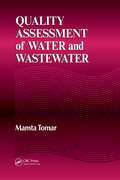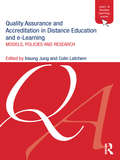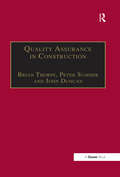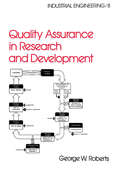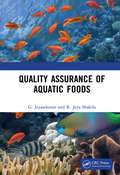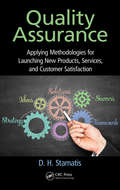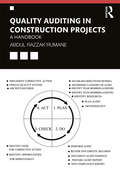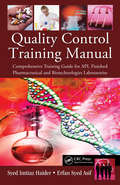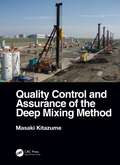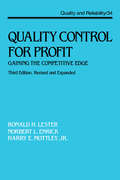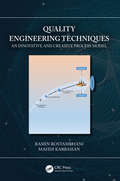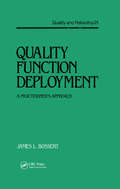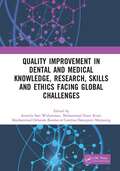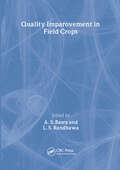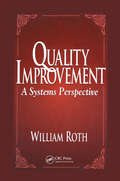- Table View
- List View
Quality Assessment of Water and Wastewater
by Mamta TomarWater is the most basic need of mankind. Drinking water is considered the most essential use of water in life. Therefore it must be free of pathogens, toxins and carcinogens. Absolutley pure water does not exist in nature. Surface water absorbs particles, carbon dioxide and other gases and mixes with silt and inorganic matters from the envir
Quality Assurance and Accreditation in Distance Education and e-Learning: Models, Policies and Research (Open and Flexible Learning Series)
by Insung Jung Colin LatchemQuality assurance (QA) in open and distance learning (ODL) can be a contentious issue. Some argue that it should be judged by the same criteria and methods as face-to-face education, while others claim that it is so different in its organization, enrolments and operations that conventional QA mechanisms cannot apply. Some advocate the use of specific guidelines and standards for e-learning; others believe that, regardless of the technology, the basic principles of quality teaching and learning should apply. Providers who have enjoyed freedom from external scrutiny may resist attempts at external regulation and auditing and look upon QA as yet another imposition of corporatization and bureaucracy on education. Others see it as a means of establishing a culture of quality, self-reflection and self-improvement. There is little research-based literature to guide policy-makers, managers and practitioners in applying QA in education and training to ensure the right balance is found between accountability and autonomy, as well as assuring quality for the time and costs involved. In this respect, Quality Assurance and Accreditation in Distance Education and e-Learning is a book that is long overdue. It explains what is involved in QA and accreditation in education. It describes and analyzes applications of these practices in open, distance, dual-mode and conventional universities throughout Europe, North America, Africa, and the Asia-Pacific, looking at open schooling, e-learning in conventional schools, non-formal adult and community education, and corporate and small-to-medium enterprises. Quality Assurance and Accreditation in Distance Education and e-Learning is edited and authored by experts with extensive international experience in ODL, e-learning and QA who give careful consideration to the possibilities and challenges involved. The book will be an invaluable guide for all policy-makers, managers, practitioners and researchers in the field.
Quality Assurance and the Law
by Richard Reeves Elaine PritchardOver the last 25 years there has been a considerable increase in the awareness of quality related issues. In the world of business and commerce, this awareness has manifested itself in the development of what was the British Quality Standard BS 5750 into what is now the international standard BS EN ISO 9000. Alongside all of this, consumers in general have developed increasingly demanding expectations with regard to the quality of goods and services available in the market place. During a similar period there has also been an increase in legislation, together with an expansion of the common law, which has strengthened the protection already afforded to the consumer. This book will provide quality practitioners, managers and those with a general interest in quality, with an insight into the legal issues involved. In addition, the book shows how the implementation of a Quality Assurance Management System - such as that required in order to be registered as a firm of assessed capability, in accordance with BS EN ISO 9000 - can act as an aid to businesses seeking to comply with their legal obligations.In addition, for those following a formal course of study, the contents will prove to be particularly useful to students undertaking the Institute of Quality Assurance's Associate Membership examination: Principles and Techniques of Quality Assurance.
Quality Assurance for the Food Industry: A Practical Approach
by J. Andres VasconcellosFood companies, regardless of their size and scope, understand that it is impossible to establish a single division devoted to "quality", as quality is the responsibility and purpose of every company employee. Applying this theory demands the cooperation of each employee and an understanding of the methodology necessary to establish, implement, and
Quality Assurance in Construction
by Peter Sumner Brian ThorpeThe need for quality assurance in construction is now widely accepted. As a result, pressure is currently being applied to contractors and those offering professional services to demonstrate QA capability prior to commission. This book, written by experts in the field of quality management, shows how construction companies can effectively apply QA within their own organization. It pinpoints the real benefits to be gained from developing well-structured systems and offers practical guidance on implementation techniques. Inevitably, quality management standards play an important role in helping to define the requirements of any QA system. With this in mind the authors provide a detailed analysis of ISO 9000 - 1994 and its implementation. The text is complemented by numerous diagrams and examples and is essential reading for all construction professionals concerned with quality.
Quality Assurance in Research and Development (Industrial Engineering: A Series of Reference Books and Textboo)
by George W. RobertsThis book provides guidelines for obtaining research and development (RD) results of a consistent and known quality. The approaches discussed here have been developed for an industrial research center engaged in RD to support operating divisions of the parent corporation.
Quality Assurance of Aquatic Foods
by G. Jeyasekaran R. Jeya ShakilaThis book deals with the quality and safety of aquatic food. It focuses clearly on biological and chemical hazards, antibiotic and pesticide residues, and heavy metal contaminants associated with aquatic food. The quality problems in various aquatic food products and their methods of assessment are exhaustively dealt in this book. Besides, food quality management systems like HACCP, SSOP, SCP, GHP, GMP have also been explained for easy adoption. The International and National Standards prescribed by FSSAI, EIC, BIS, Codex, USFDA, ISO and EU for aquatic food products are explicitly given. It is also useful to the personnel of aquatic food industries to improve their working knowledge on maintaining the quality and safety aquatic foods. Note: T& F does not sell or distribute the Hardback in India, Pakistan, Nepal, Bhutan, Bangladesh and Sri Lanka.
Quality Assurance of Welded Construction
by N. T. BurgessSince the first edition of this book was published, most developments in welding construction have been within the quality assurance element of the process rather than in welding technology itself.The continuous pressures from worldwide clients seeking better reliability from welded structures has focused much attention on to quality.The quality ch
Quality Assurance: Applying Methodologies for Launching New Products, Services, and Customer Satisfaction (Practical Quality Of The Future Ser.)
by D. H. StamatisAlthough regularly introducing new products or services is the lifeblood of most industries, bringing them to market can be fraught with peril. Timing, cost, and quality all play important roles in a successful product launch and avoiding expensive- often in more than just dollars- recalls and redesigns. Quality Assurance: Applying Methodologies fo
Quality Auditing in Construction Projects: A Handbook
by Abdul Razzak RumaneThis book provides construction professionals, designers, contractors and quality auditors involved in construction projects with the auditing skills and processes required to improve construction quality and make their projects more competitive and economical. The processes within the book focus on auditing compliance to ISO, corporate quality management systems, project specific quality management systems, contract management, regulatory authorities’ requirements, safety, and environmental considerations. The book is divided into seven chapters and each chapter is divided into numbered sections covering auditing-related topics that have importance or relevance for understanding quality auditing concepts for construction projects. No other book covers construction quality auditing in such detail and with this level of practical application. It is an essential guide for construction and quality professionals, but also for students and academics interested in learning about quality auditing in construction projects.
Quality Beyond Six Sigma: A Lean Approach To Building Sustainable Quality Beyond Six Sigma
by Ron Basu Nevan WrightSix Sigma is a data-driven management system with near-perfect performance that is a statistical target of operating with no more that 3.4 defects per one million chances. Six sigma has both created avid interest and raised concerns among executives and its practioners. This is all very well for multinationals like Motorola or General Electric but how can it help small and medium-sized enterprises or the service industry? How do you ensure that solutions stick? Quality Beyond Six Sigma responds to this challenge and provides a practical implementation of the issues of Six Sigma, Lean Enterprise and Total Quality and aligns the 'hard' sigma message with the softer sustainable 'strategic issues'. The result is FIT SIGMA.The authors utilize major and minor case studies to support principles and learnings of FIT SIGMA and include review examples and self-assessment that underpin the sustainable process. The three major case studies are contributed by General Electric, Dow Chemical and Seagate Technology.Senior Executives and Managers of organizations of all types and sizes, Management Consultants and Students of all disciplines will find this book a stimulating guide to quality and operational excellence.
Quality Control Training Manual: Comprehensive Training Guide for API, Finished Pharmaceutical and Biotechnologies Laboratories
by Syed Imtiaz Haider Syed Erfan AsifWritten to help companies comply with GMP, GLP, and validation requirements imposed by the FDA and regulatory bodies worldwide, Quality Control Training Manual: Comprehensive Training Guide for API, Finished Pharmaceutical and Biotechnologies Laboratories presents cost-effective training courses that cover how to apply advances in the life sciences to produce commercially viable biotech products and services in terms of quality, safety, and efficacy. This book and its accompanying downloadable resources comprise detailed text, summaries, test papers, and answers to test papers, providing an administrative solution for management. Provides the FDA, Health Canada, WHO, and EMEA guidelines directly applicable to pharmaceutical laboratory-related issues Offers generic formats and styles that can be customized to any organization and help management build quality into routine operations to comply with regulatory requirements Contains ready-to-use training courses that supply a good source of training material for experienced and inexperienced practitioners in the biotechnology/biopharmaceutical industries Includes downloadable resources with downloadable training courses that can be adopted and directly customized to a particular organization Supplies ready-to-use test papers that allow end users to record all raw data up to the issuance of the attached certificate The biotechnology/bioscience industries are regulated worldwide to be in compliance with cGMP and GLP principles, with particular focus on safety issues. Each company must create a definite training matrix of its employees. The training procedures in this book enable end users to understand the principles and elements of manufacturing techniques and provide documentation language ranging from the generic to the specific. The training courses on the downloadable resources supply valuable tools for developing training matrices to achieve FDA, Health Canada, EMEA, MHRA UK, WHO, and GLP compliance.
Quality Control and Assurance of the Deep Mixing Method
by Masaki KitazumeThe deep mixing (DM) method developed in Japan and Sweden in the 1970s has gained popularity worldwide. The DM-improved ground is a composite system comprising stiff stabilized soil and unstabilized soft soil, which necessitates geotechnical engineers to fully understand the interaction of stabilized and unstabilized soils and the engineering characteristics of in-situ stabilized soil. The success of the DM project cannot be achieved by the well-determined geotechnical design alone but is guaranteed only when the quality and geometric layout envisaged in the design is realized in the field with an acceptable level of accuracy. The process design, production with careful quality control and quality assurance are the key issues in the DM project. This book is intended to provide the state of the art and practice of quality control and assurance on deep mixing in detail based on the experience and research efforts accumulated in the past 50 years.
Quality Control and Regulatory Aspects for Biologicals: Regulations and Best Practices
by Gauri MisraThis book serves as a comprehensive guide on quality control and regulatory aspects for biological products. It covers a wide range of topics, including regulatory requirements, quality control strategies, analytical methods, and risk management. It delves into the advantages and limitations of in vivo tests and discusses alternative methods that can be employed. The book explores the use of animal-based testing methods in quality control and examines viable alternatives.Key Features: Reviews various scientific and regulatory aspects involved in the quality control of biologicals Provides an overview of the roles of various national and international regulatory bodies and accreditation agencies Presents advanced analytical methods, innovative technologies, and the integration of molecular diagnostics in quality control processes Explores the use of animal-based testing methods in quality control, as well as their alternatives Discusses guidelines and methodologies involved in the development of biological products Overall, this book is an important reference source for various professionals in the pharmaceutical industry, including researchers, scientists, quality control personnel, and regulatory affairs professionals.
Quality Control for Profit: Gaining the Competitive Edge, Third Edition, (Quality and Reliability)
by Ronald H. Lester Norbert L. Enrick Harry E. Mottley Jr.This book focuses on practical proven programs that have enabled companies to gain a worldwide competitive edge. The blending of total quality control with total employee involvement and just-in-time manufacturing concepts provides the means for gaining the competitive edge.
Quality Control of Concrete Structures: Proceedings of the Second International RILEM/CEB Symposium
by L. Taerwe H. LambotteThis book details the latest information on the applied methods and techniques being used for quality control of concrete construction worldwide. The book forms the proceedings of the Second International Symposium on Quality Control on Concrete Structures, held in Belgium, June 1991.
Quality Engineering Handbook (Quality and Reliability)
by Thomas Pyzdek Paul A. KellerWritten by one of the foremost authorities on the subject, the Second Edition is completely revised to reflect the latest changes to the ASQ Body of Knowledge for the Certified Quality Engineer (CQE). This handbook covers every essential topic required by the quality engineer for day-to-day practices in planning, testing, finance, and management an
Quality Engineering Techniques: An Innovative and Creative Process Model
by Ramin Rostamkhani Mahdi KarbasianIn today’s industrial and complex world, the progress of change is incredible. The amount of information which needs to be analyzed is very large and time has become more and more limited. Industries and firms of all sizes desire to increase productivity and sustainability to keep their competitive edge in the marketplace. One of the best tools for achieving this is the application of Quality Engineering Techniques (QET). This book will introduce the integrated model and the numerical applications for implementing it.
Quality Engineering: Off-Line Methods and Applications
by Chao-Ton SuAs quality becomes an increasingly essential factor for achieving business success, building quality improvement into all stages-product planning, product design, and process design-instead of just manufacturing has also become essential. Quality Engineering: Off-Line Methods and Applications explores how to use quality engineering methods and othe
Quality Function Deployment: The Practitioner's Approach
by James L. BossertQuality Function Deployment is an information system producing structured data for quality managers and practitioners. This is a practical guide to implementing such a system for readers assumed to be familiar with it. Annotation copyright Book News, Inc. Portland, Or.
Quality Improvement Techniques in Construction: Principles and Methods (Chartered Institute of Building)
by Steven MccabeQuality management has received much attention in recent years, not least in the construction industry. This book provides a description of the techniques of quality management and how they are implemented, regardless of the context. The author applies the techniques to the construction industry and brings in some practical experience from contractors in the construction industry.
Quality Improvement in Dental and Medical Knowledge, Research, Skills and Ethics Facing Global Challenges: Proceedings of the International Conference on Technology of Dental and Medical Sciences (ICTDMS 2022), Jakarta, Indonesia, 8-10 December 2022
by Armelia Sari Widyarman Muhammad Ihsan Rizal Moehammad Orliando Roeslan Carolina Damayanti MarpaungThe proceeding of FORIL XIII 2022 Scientific Forum Usakti conjunction with International Conference on Technology of Dental and Medical Sciences (ICTDMS) includes selected full papers that have been peer-reviewed and satisfy the conference's criteria. All studies on health, ethics, and social issues in the field of dentistry and medicine have been presented at the conference alongside clinical and technical presentations. The twelve primary themes that make up its framework include the following: behavioral epidemiologic, and health services, conservative dentistry, dental materials, dento-maxillofacial radiology, medical sciences and technology, oral and maxillofacial surgery, oral biology, oral medicine and pathology, orthodontics, pediatrics dentistry, periodontology, and prosthodontics. This proceeding is likely to be beneficial in keeping dental and medical professionals apprised of the most recent scientific developments.
Quality Improvement in Field Crops
by Lakhwinder S RandhawaLearn to identify, modify, and manipulate the genes controlling key quality traits in field crops!This informative book provides state-of-the-art information on improving nutritional quality as well as yield volume in field crops such as wheat, maize, rice, barley, oats, lentils, pigeon peas, soybeans, cool season legumes, and crops whose seeds are used to make oils. With contributions from leading authorities in the field, this book will bring you up to date on the uses of agronomic management, conventional plant breeding, and modern biotechnologies in improving the quality of important food, feed, and fiber products.Quality Improvement in Field Crops examines: factors that impact the end-use quality of wheat and ways to improve wheat’s quality for milling and baking agronomic practices that impact the quality of maize ways to improve the nutritional value of rice and legumes techniques for using molecular markers to improve the quality of lentil crops breeding methods that can improve the quality of the oils derived from oilseed crops protein quality/sulfur metabolism in soybeans and much more!This book is dedicated to the World Food Laureate (the equivalent of the Nobel Prize for food scientists), Dr. G. S. Khush--the father of the Green Revolution in rice farming--in recognition of his tremendous contributions to global food and nutritional security for the world?s population.
Quality Improvement: A Systems Perspective
by William RothQuality improvement: it's an attractive concept on paper. So why do the vast majority of quality improvement efforts fail?William Roth knows from experience: as a Ph.D in systems theory, an ex-corporate manager, a professor-and the designer (with the AQP) of a national program to deliver training for quality credentials in the systems approach. His belief: enduring quality improvement is an "all or nothing" situation-requiring a systemic approach, with all the key components and integrations in place and fully integrated right from the start. Quality Improvement: A Systems Perspective explains the sometimes surprising historic roots of the quality improvement movement, and outlines the systems theory on which successful models must be built. Readers then gain access to the hands-on, nuts-and-bolts, how-to-get-it-done details of the five critical phases. Three case studies (two in industry, one in health care) support this traditional but currently shunned model.Along with his unique unified view of quality improvement, Roth explains why it is shunned, and why alternative approaches usually do not produce the desired results. Key obstacles to success are directly identified-top-level management, local union leaders, management education. The ultimate culprit, though, is culture-to which Roth suggests how to move organizations in the right direction, from a systems perspective.With one of the most comprehensive overviews of quality management essentials in one volume, Quality Improvement: A Systems Perspective balances theory and modeling with the details of real-life implementation and success.
Quality Lighting for High Performance Buildings
by Michael StillerThis book provides an overview of the basic concepts of quality, indoor lighting, and explains concepts like visual comfort, visual interest, and integrated design as they relate to the practice of lighting design. Energy-efficient lighting technologies, including LED lighting and digital control systems, and design strategies that increase visual comfort and productivity are discussed in plain language, and examined in a straightforward way to give the reader, whether an architect, interior designer, engineer, building trades professional, or student a broad understanding of the art and science of energy-efficient quality lighting.
